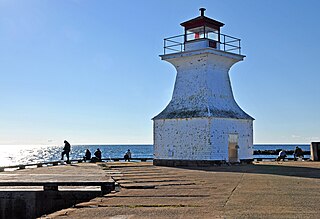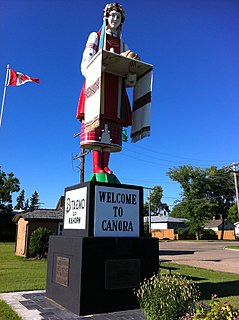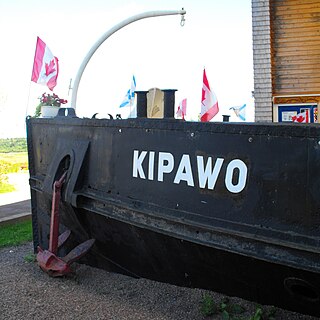
Marine Atlantic Inc. is an independent Canadian federal Crown corporation which is mandated to operate ferry services between the provinces of Newfoundland and Labrador and Nova Scotia.

Cape Tormentine is a village in southeastern New Brunswick, Canada. It is located on the Northumberland Strait at the Abegweit Passage, the shortest crossing between Prince Edward Island and the mainland. It once flourished as a transportation hub between New Brunswick and Prince Edward Island but has been in decline since 1997 when the ferry service was closed due to the opening of the Confederation Bridge. At the Canada 2011 Census the population was 108, three quarters what it was at the 2006 census.

MV Abegweit was an icebreaking railway, vehicle, and passenger ferry which operated across the Abegweit Passage of Northumberland Strait, connecting Port Borden to Cape Tormentine between 1947 and 1982.

Eureka is a side-wheel paddle steamboat, built in 1890, which is now preserved at the San Francisco Maritime National Historical Park in San Francisco, California. Originally named Ukiah to commemorate the railway's recent extension into the City of Ukiah, the boat was built by the San Francisco and North Pacific Railroad Company at their Tiburon yard. Eureka has been designated a National Historic Landmark and was listed in the National Register of Historic Places on April 24, 1973.

M/V William Carson was a CN Marine passenger/vehicle icebreaker ferry named in honour of Newfoundland colonial politician William Carson.
The Lochside Regional Trail is a 29-kilometre (18-mile) trail that runs from the Swartz Bay Ferry Terminal to Victoria, British Columbia, Canada. The trail is a popular route both for commuting and recreation. It is frequented by people walking, running, cycling, skateboarding and riding horses.

Canora is located at the junction of highways No. 5 and 9 in east central Saskatchewan.

The Owen Sound Transportation Company, Limited was the forerunner of the enterprise that currently operates the vehicle and passenger ferry - M.S. Chi-Cheemaun - between Tobermory on the Bruce Peninsula, and South Baymouth on Manitoulin Island. For updated information, see the article on the M.S. Chi-Cheemaun.

MV Kipawo is a historic Canadian passenger and freight ferry built to operate in the Bay of Fundy and which later served in Newfoundland and inspired the creation of a theater company.

The South Pacific Coast Railroad (SPC) was a 3 ft narrow gauge steam railroad running between Santa Cruz, California and Alameda, with a ferry connection in Alameda to San Francisco. The railroad was created as the Santa Clara Valley Railroad, founded by local strawberry growers as a way to get their crops to market in San Francisco and provide an alternative to the Southern Pacific Railroad. In 1876, James Graham Fair, a Comstock Lode silver baron, bought the line and extended it into the Santa Cruz Mountains to capture the significant lumber traffic coming out of the redwood forests. The narrow-gauge line was originally laid with 52-pound-per-yard (26 kg/m) rail on 8-foot (2.44 m) redwood ties; and was later acquired by the Southern Pacific and converted to 4 ft 8 1⁄2 instandard gauge.

The steamboat Daily operated in the early 1900s as part of the Puget Sound Mosquito Fleet. In later years, Daily was renamed Island Princess and later Cy Peck.

TSMV Shanklin was a passenger ferry that operated between Portsmouth and the Isle of Wight between 1951 and 1980. Renamed the Prince Ivanhoe she went on to become a pleasure cruiser in the Bristol Channel but in 1981 sank off the Welsh coast on her first season.

Asbury Park was a high-speed coastal steamer built in Philadelphia, and intended to transport well-to-do persons from New York to summer homes on the New Jersey shore. This vessel was sold to West Coast interests in 1918, and later converted to an automobile ferry, serving on various routes San Francisco Bay, Puget Sound and British Columbia. This vessel was known by a number of other names, including City of Sacramento, Kahloke, Langdale Queen, and Lady Grace.

SS Princess Helene was a historic Canadian passenger and freight ferry operated by the Canadian Pacific Railway (CPR).

RML 497 is a former Royal Navy Fairmile B motor launch from World War II. She was named Western Lady III on her entry to civilian service, as a passenger motor vessel for Western Lady Ferry Service. From 2009 to 2015, she operated as The Fairmile for Greenway Ferry on their day cruise route from Torquay and Brixham to Dartmouth and Greenway. In May 2013, she was returned to her original wartime appearance. Torbay's "ferry wars" forced her removal from service, and in December 2015, RML 497 was acquired by the National Museum of the Royal Navy.
One of three railways to operate on the Saanich Peninsula, the Victoria and Sidney Railway Company was formed in 1892 as part of the City of Victoria's plan for a rail line serve the Saanich Peninsula. After granting the V&S certain tax concessions and various loans construction began on a rail line from downtown Victoria to downtown Sidney. Surveying and grading soon began and passed through nearly every important community between Victoria and Sidney. Operations began in 1894 and at the time the Saanich Peninsula was mostly forested with only limited areas under cultivation. Timber and cordwood production was key industry in the area and provided a major source of freight revenue for the railroad. Since all the early V&S locomotives were wood burners, local residents quickly dubbed the train the "Cordwood Limited". A slightly less complimentary name for it was the "tri-weekly" because although it ran every day, it tried weakly.

Princess Marguerite, Princess Marguerite II, and Princess Marguerite III was a series of Canadian coastal passenger vessels that operated along the west coast of British Columbia and into Puget Sound in Washington State almost continuously from 1925 to 1999. Known locally as “the Maggie”, they saw the longest service of any vessel that carried passengers and freight between Victoria, Vancouver, and Seattle. The vessels were owned and operated by a series of companies, primarily Canadian Pacific Railway Company (CPSS) and British Columbia Steamships Corporation. The first two were part of the CPR "Princess fleet," which was composed of ships having names which began with the title "Princess". These were named after Marguerite Kathleen Shaughnessy, who was not a princess but was the daughter of Baron Thomas Shaughnessy, then chairman of the board of CPSS's parent, the Canadian Pacific Railway (CPR).
MV Bluenose was a Canadian passenger and motor vehicle ferry operated by Canadian National Railways and later CN Marine from 1955 to 1982. She sailed between Bar Harbor, Maine and Yarmouth, Nova Scotia. The vessel was named after the famed Grand Banks fishing and racing schooner Bluenose.

TSMV Southsea was a passenger ferry that operated between Portsmouth and the Isle of Wight between 1948 and 1987.


















